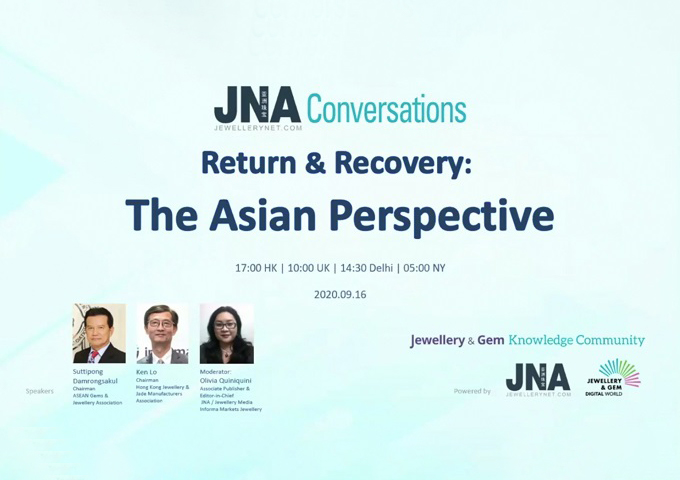Market diversification, new business models and digital initiatives are key to speeding up recovery in Asia’s gemstone and jewellery sector, industry veterans said during the first JNA Conversations webinar: Return & Recovery – The Asian Perspective on September 16.
The event featured Ken Lo, chairman of the Hong Kong Jewellery & Jade Manufacturers Association, and Suttipong Damrongsakul, chairman of the ASEAN Gems & Jewellery Association (AGJA), as speakers.
Organised by JNA, the webinar cast the spotlight on key lessons from the coronavirus pandemic and recovery measures in the gem and jewellery sectors of Hong Kong, Thailand and the ASEAN (Association of Southeast Asian Nations) region.
Recovery efforts
According to Lo, the Covid-19 pandemic gravely affected jewellery supply chains globally hence the need to diversify production bases. For instance, more than 90 per cent of Hong Kong’s manufacturing facilities are located in mainland China so problems arose from sending materials there for processing due to lockdowns and border closures.
“We have since started relocating some manufacturing facilities back to Hong Kong. Cad/cam production can now be done in Hong Kong,” Lo explained during the webinar. “In the future, we have to set up a skeleton type of facility here, so when something unprecedented happens, we’ll still have capacity in Hong Kong.”
Exports were also hit hard by the pandemic. Hong Kong recorded a 38.4 per cent drop in gem and jewellery exports from January to July this year.
Among Hong Kong’s top export destinations, western countries showed the largest dip in business volume. “Only China and Hong Kong exhibited growth and surprisingly, Middle East – UAE and Qatar also showed slight increases,” noted Lo.
This brings to the fore the need for market diversification and less dependence on a single market such as the US. Companies should instead refocus on China and ASEAN.
For his part, Suttipong said ASEAN jewellers likewise suffered immensely from the pandemic. ASEAN, a leading jewellery manufacturing base, mainly has clients in the US, Europe and China. These countries however were placed under lockdown for months.
Manufacturing companies were left with no choice but to suspend or downsize operations as well as reduce production and expenses. Thailand’s gem and jewellery exports from January to July 2020 dropped by 41.87 per cent while other ASEAN countries likewise experienced major declines.
“We have learned a very important lesson during this pandemic. This has forced many companies to consider creating branding and O2O concepts as part of a long-term strategy,” noted Suttipong.
The AGJA official also proposed revising business models where factories can partner with jewellery design companies or digital technology firms to maximise opportunities and share expertise.
“Manufacturing companies can no longer stand alone, with hundreds or thousands of people making everything in one facility,” explained Suttipong. “Looking ahead, there could be partnerships among gem and jewellery companies. This could be a future business model.”
This is particularly crucial to online initiatives since most ASEAN manufacturers may be lagging behind their western counterparts in terms of digitalisation.
Outlook
According to Lo, China could lead recovery efforts in the jewellery sector since it is the first economy to emerge from the Covid-19 pandemic. Businesses there resumed in May and are likely to continue to grow throughout 2020.
“China will undoubtedly become the future major market for fine jewellery. Traditional jewellery markets such as the US and Europe will take time to recover so we really have to look at the Asian market in the coming year,” he noted.
Companies should also invest more in digital marketing as an effective promotional and communications tool especially for younger consumers.
Lo also reiterated the value of physical jewellery trade fairs, which provide the most ideal platform for sellers and buyers, particularly for those dealing in high-value items.
Suttipong meannwhile echoed Lo’s sentiment on market diversification. “In the past, we seem to have relied heavily on a single market. ASEAN companies mostly exported to the US, Europe and China. When those markets experience problems, everything shuts down in this part of the world. It’s time to consider a shift from the west to the east,” he noted.
A recording of the JNA Conversations: Return & Recovery – The Asian Perspective can be viewed here.
Part of the Jewellery & Gem Knowledge Community education-based programme, the Return & Recovery series of webinars is being held ahead of Informa Markets Jewellery’s first-ever virtual event, Jewellery & Gem Digital World from October 27 to 29, 2020.










